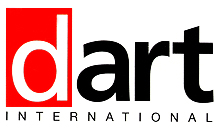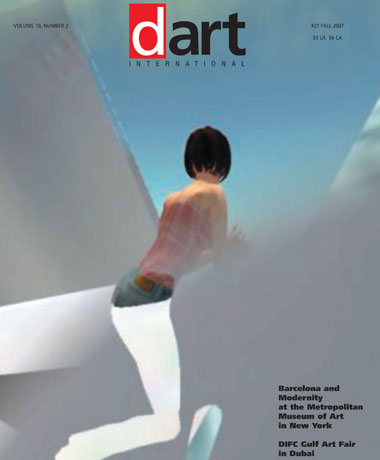| |||
Gulf Art Fair in Dubai by Janet Bellotto Mohammed Kazem, Eva Scharrer and Jonathan Watkins shared the stage of curating the 8th Sharjah Biennial Still Life: Art, Ecology and the Politics of Change.
With Christie’s auction house which opened up in Dubai in 2006, and a handful of contemporary commercial galleries merging into the industrial district of Al Quoz, fair director John Martin has taken the challenge of creating a viable international platform in Dubai where regional artists could exhibit on similar ground as their peers do in the west, but also as a new hub for art commerce. This idea has been strengthened by the recent museum plans to construct a Guggenheim and Louvre in the UAE capital Abu Dhabi. We have seen this region rapidly developing, particularly in the financial and real estate sector, but now there is a move to focus on what has been neglected, a vision for art and culture. The build up to the fair had local art enthusiasts antsy to look and later filled with curiosity of how the galleries were doing. It has brought in personalities like New York artist Fred Eversley who in a matter of hours got people connected and chatting. In fact he made the comparison that the Dubai fair was not unlike the first Art Basel, in which he participated. Other dealers also visited to see if the fuss lived up to expectaions. We could draw some distinct generalizations of what the galleries were selling: glittering gold and dollar signs. We had Andy Warhol’s silkscreen print of dollar signs contrasted with Andrei Molodkin’s acrylic dollar sign sculpture filled with crude oil. There was the usual range from Picasso and Warhol to more contemporary works by Gabriel Orozco, Sam Taylor-Wood, Candida Höfer, Lee Bull, Shilpa Gupta, Walid Raad/Atlas Group and more. There was also the fun and the functional like Damien Hirst’s polka dotted Mini. Visitors were also treated to enchanting works that pushed the boundaries of optical illusion like Patrick Hughes’ Sea City. And if the art wasn’t enough there was a great line up of speaker panels with the likes of Jerome Sans, Hans Ülrich Obrist, Camilla Cañellas and Donna De Salvo. Attendance of Emiratis at the opening or the public event was scant, but then again the population is made of 85 per cent of ex-patriots. However, this leads to the interesting discussion, not unlike one that developed during the open forum Contemporary Arab and Iranian Art – What are the artists creating today? Ian Findlay-Brown, Editor/ Publisher of Asian Art News livened up the conversation when he made the comparison that what is happening in the Middle East now, is what was happening in China some years ago. An underlying reality, though, is that the fair cannot just be about selling, as the foundation is still being built. Along with the local galleries and international entities, it is also about educating a young but growing collectors market. "Is the affect occurring again with closing out certain cultures?" So the comparison was made "How could you have the Renaissance without the Medicis?" The only other fair competition running was the Creek Fair. This fair showcased a handful of local and regional galleries housed in the historical maze of buildings and windtowers in Bastakiya. Corporations are playing a larger role in the promotion of the arts in Dubai; investment, like buildings, continues to grow. Will the growing gallery scene and art presentations help nurture a new stream of art collectors? March 12-15 of next year will ultimately tell us if Dubai is good for art business. One to watch for in 2008 is the International Design Forum. This past May 27 the Forum in Dubai began with three days of sessions discussing design in the Arab world, internationally and the future of design. Names like Karim Rashid, Rem Koolhaas, Zaha Hadid, were among the honored, unfortunately Zaha was a no show, but Rashid was a splash on opening day talking about the future of design. Local design students had a lot to say during the sessions, particularly when it came to Dubai and the direction it is going. For a summary on the 2007 forum visit moutamarat.com. |
|||

 The DIFC Gulf Art Fair hit Dubai on the same weekend of two other major events – the Jazz Festival and Desert Rock. Although a cosmopolitan city, large, attention-grabbing events are still few to come by, and "Art" is a very fresh concept. Although the streets around Dubai were aligned with DIFC Gulf Art Fair banners, Emiratis (citizens of the United Arab Emirates – UAE) and expats (everyone else living in Dubai) alike were still puzzled of where the art fair was actually being held. There was no indication where you might find it, unless you paid close attention to advertising or were curious enough to research it. Unlike the art fairs overflowing in Miami, or the Armory Show in New York, the 40 some galleries at the DIFC Gulf Art Fair was enough for its first run that was held at the Madinat Arena – near Dubai’s icon 7-star hotel the Burj Al Arab. Also, unlike other fairs the press preview had not only brought in critics from various countries but national journalists and photographers hurdled over each other to get the best shot of the first tour given by fair director John Martin and DIFC governor Dr. Omar Bin Sulaiman. An interesting encounter occurred when I instinctively reached out to save a painted from being squashed by a backpack. The photographer in question turned and said "I didn’t ask to be sent here." For some at the fair, Art seemed merely to be wallpaper, while a refreshing welcome to others for a city where glimpses of such a variety of artwork is rare.
The DIFC Gulf Art Fair hit Dubai on the same weekend of two other major events – the Jazz Festival and Desert Rock. Although a cosmopolitan city, large, attention-grabbing events are still few to come by, and "Art" is a very fresh concept. Although the streets around Dubai were aligned with DIFC Gulf Art Fair banners, Emiratis (citizens of the United Arab Emirates – UAE) and expats (everyone else living in Dubai) alike were still puzzled of where the art fair was actually being held. There was no indication where you might find it, unless you paid close attention to advertising or were curious enough to research it. Unlike the art fairs overflowing in Miami, or the Armory Show in New York, the 40 some galleries at the DIFC Gulf Art Fair was enough for its first run that was held at the Madinat Arena – near Dubai’s icon 7-star hotel the Burj Al Arab. Also, unlike other fairs the press preview had not only brought in critics from various countries but national journalists and photographers hurdled over each other to get the best shot of the first tour given by fair director John Martin and DIFC governor Dr. Omar Bin Sulaiman. An interesting encounter occurred when I instinctively reached out to save a painted from being squashed by a backpack. The photographer in question turned and said "I didn’t ask to be sent here." For some at the fair, Art seemed merely to be wallpaper, while a refreshing welcome to others for a city where glimpses of such a variety of artwork is rare.